Order-7-3 triangular honeycomb
In the geometry of hyperbolic 3-space, the order-7-3 triangular honeycomb (or 3,7,3 honeycomb) is a regular space-filling tessellation (or honeycomb) with Schläfli symbol {3,7,3}.
| Order-7-3 triangular honeycomb | |
|---|---|
| Type | Regular honeycomb |
| Schläfli symbols | {3,7,3} |
| Coxeter diagrams | |
| Cells | {3,7} |
| Faces | {3} |
| Edge figure | {3} |
| Vertex figure | {7,3} 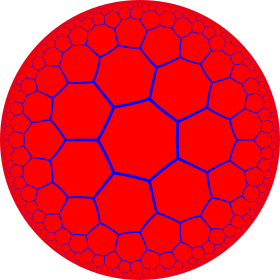 |
| Dual | Self-dual |
| Coxeter group | [3,7,3] |
| Properties | Regular |
Geometry
It has three order-7 triangular tiling {3,7} around each edge. All vertices are ultra-ideal (existing beyond the ideal boundary) with infinitely many triangular tilings existing around each vertex in a heptagonal tiling vertex figure.
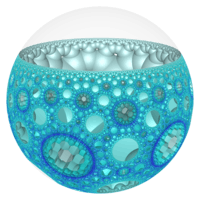 Poincaré disk model |
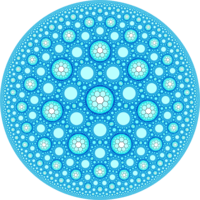 Ideal surface |
 Upper half space model with selective cells shown[1] |
Related polytopes and honeycombs
It a part of a sequence of self-dual regular honeycombs: {p,7,p}.
It is a part of a sequence of regular honeycombs with order-7 triangular tiling cells: {3,7,p}.
It isa part of a sequence of regular honeycombs with heptagonal tiling vertex figures: {p,7,3}.
Order-7-4 triangular honeycomb
| Order-7-4 triangular honeycomb | |
|---|---|
| Type | Regular honeycomb |
| Schläfli symbols | {3,7,4} |
| Coxeter diagrams | |
| Cells | {3,7} |
| Faces | {3} |
| Edge figure | {4} |
| Vertex figure | {7,4} 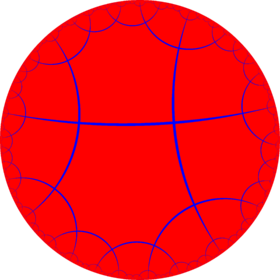 r{7,7}  |
| Dual | {4,7,3} |
| Coxeter group | [3,7,4] |
| Properties | Regular |
In the geometry of hyperbolic 3-space, the order-7-4 triangular honeycomb (or 3,7,4 honeycomb) is a regular space-filling tessellation (or honeycomb) with Schläfli symbol {3,7,4}.
It has four order-7 triangular tilings, {3,7}, around each edge. All vertices are ultra-ideal (existing beyond the ideal boundary) with infinitely many order-7 triangular tilings existing around each vertex in an order-4 hexagonal tiling vertex arrangement.
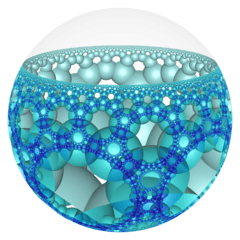 Poincaré disk model |
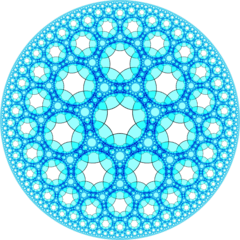 Ideal surface |
It has a second construction as a uniform honeycomb, Schläfli symbol {3,71,1}, Coxeter diagram, ![]()
![]()
![]()
![]()
![]()
Order-7-5 triangular honeycomb
| Order-7-5 triangular honeycomb | |
|---|---|
| Type | Regular honeycomb |
| Schläfli symbols | {3,7,5} |
| Coxeter diagrams | |
| Cells | {3,7} |
| Faces | {3} |
| Edge figure | {5} |
| Vertex figure | {7,5} |
| Dual | {5,7,3} |
| Coxeter group | [3,7,5] |
| Properties | Regular |
In the geometry of hyperbolic 3-space, the order-7-3 triangular honeycomb (or 3,7,5 honeycomb) is a regular space-filling tessellation (or honeycomb) with Schläfli symbol {3,7,5}. It has five order-7 triangular tiling, {3,7}, around each edge. All vertices are ultra-ideal (existing beyond the ideal boundary) with infinitely many order-7 triangular tilings existing around each vertex in an order-5 heptagonal tiling vertex figure.
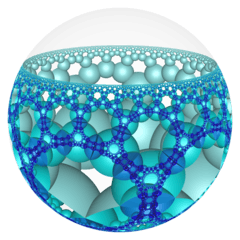 Poincaré disk model |
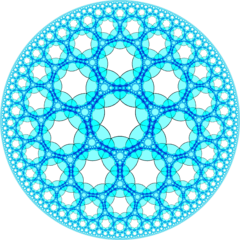 Ideal surface |
Order-7-6 triangular honeycomb
| Order-7-6 triangular honeycomb | |
|---|---|
| Type | Regular honeycomb |
| Schläfli symbols | {3,7,6} {3,(7,3,7)} |
| Coxeter diagrams | |
| Cells | {3,7} |
| Faces | {3} |
| Edge figure | {6} |
| Vertex figure | {7,6} {(7,3,7)} |
| Dual | {6,7,3} |
| Coxeter group | [3,7,6] |
| Properties | Regular |
In the geometry of hyperbolic 3-space, the order-7-6 triangular honeycomb (or 3,7,6 honeycomb) is a regular space-filling tessellation (or honeycomb) with Schläfli symbol {3,7,6}. It has infinitely many order-7 triangular tiling, {3,7}, around each edge. All vertices are ultra-ideal (existing beyond the ideal boundary) with infinitely many order-7 triangular tilings existing around each vertex in an order-6 heptagonal tiling, {7,6}, vertex figure.
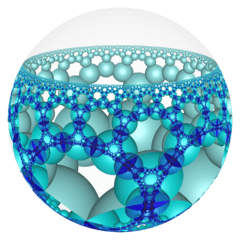 Poincaré disk model |
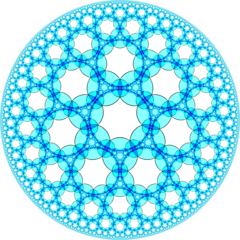 Ideal surface |
Order-7-infinite triangular honeycomb
| Order-7-infinite triangular honeycomb | |
|---|---|
| Type | Regular honeycomb |
| Schläfli symbols | {3,7,∞} {3,(7,∞,7)} |
| Coxeter diagrams | |
| Cells | {3,7} |
| Faces | {3} |
| Edge figure | {∞} |
| Vertex figure | {7,∞} {(7,∞,7)} |
| Dual | {∞,7,3} |
| Coxeter group | [∞,7,3] [3,((7,∞,7))] |
| Properties | Regular |
In the geometry of hyperbolic 3-space, the order-7-infinite triangular honeycomb (or 3,7,∞ honeycomb) is a regular space-filling tessellation (or honeycomb) with Schläfli symbol {3,7,∞}. It has infinitely many order-7 triangular tiling, {3,7}, around each edge. All vertices are ultra-ideal (existing beyond the ideal boundary) with infinitely many order-7 triangular tilings existing around each vertex in an infinite-order heptagonal tiling, {7,∞}, vertex figure.
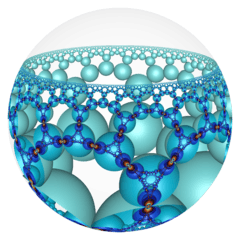 Poincaré disk model |
 Ideal surface |
It has a second construction as a uniform honeycomb, Schläfli symbol {3,(7,∞,7)}, Coxeter diagram, ![]()
![]()
![]()
![]()
![]()
![]()
![]()
![]()
![]()
![]()
![]()
![]()
![]()
Order-7-3 square honeycomb
| Order-7-3 square honeycomb | |
|---|---|
| Type | Regular honeycomb |
| Schläfli symbol | {4,7,3} |
| Coxeter diagram | |
| Cells | {4,7} 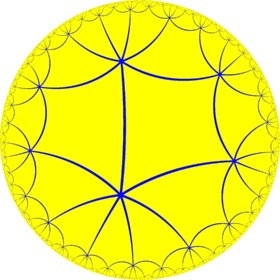 |
| Faces | {4} |
| Vertex figure | {7,3} |
| Dual | {3,7,4} |
| Coxeter group | [4,7,3] |
| Properties | Regular |
In the geometry of hyperbolic 3-space, the order-7-3 square honeycomb (or 4,7,3 honeycomb) a regular space-filling tessellation (or honeycomb). Each infinite cell consists of a heptagonal tiling whose vertices lie on a 2-hypercycle, each of which has a limiting circle on the ideal sphere.
The Schläfli symbol of the order-7-3 square honeycomb is {4,7,3}, with three order-4 heptagonal tilings meeting at each edge. The vertex figure of this honeycomb is a heptagonal tiling, {7,3}.
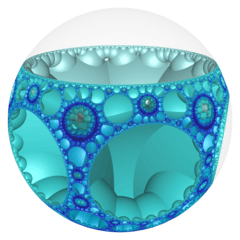 Poincaré disk model |
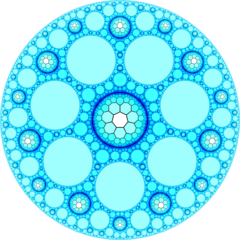 Ideal surface |
Order-7-3 pentagonal honeycomb
| Order-7-3 pentagonal honeycomb | |
|---|---|
| Type | Regular honeycomb |
| Schläfli symbol | {5,7,3} |
| Coxeter diagram | |
| Cells | {5,7}  |
| Faces | {5} |
| Vertex figure | {7,3} |
| Dual | {3,7,5} |
| Coxeter group | [5,7,3] |
| Properties | Regular |
In the geometry of hyperbolic 3-space, the order-7-3 pentagonal honeycomb (or 5,7,3 honeycomb) a regular space-filling tessellation (or honeycomb). Each infinite cell consists of an order-7 pentagonal tiling whose vertices lie on a 2-hypercycle, each of which has a limiting circle on the ideal sphere.
The Schläfli symbol of the order-6-3 pentagonal honeycomb is {5,7,3}, with three order-7 pentagonal tilings meeting at each edge. The vertex figure of this honeycomb is a heptagonal tiling, {7,3}.
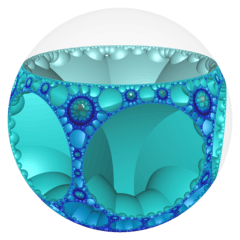 Poincaré disk model |
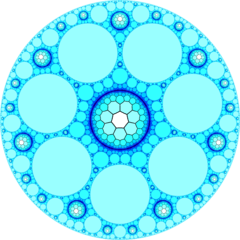 Ideal surface |
Order-7-3 hexagonal honeycomb
| Order-7-3 hexagonal honeycomb | |
|---|---|
| Type | Regular honeycomb |
| Schläfli symbol | {6,7,3} |
| Coxeter diagram | |
| Cells | {6,7}  |
| Faces | {6} |
| Vertex figure | {7,3} |
| Dual | {3,7,6} |
| Coxeter group | [6,7,3] |
| Properties | Regular |
In the geometry of hyperbolic 3-space, the order-7-3 hexagonal honeycomb (or 6,7,3 honeycomb) a regular space-filling tessellation (or honeycomb). Each infinite cell consists of an order-6 hexagonal tiling whose vertices lie on a 2-hypercycle, each of which has a limiting circle on the ideal sphere.
The Schläfli symbol of the order-7-3 hexagonal honeycomb is {6,7,3}, with three order-5 hexagonal tilings meeting at each edge. The vertex figure of this honeycomb is a heptagonal tiling, {7,3}.
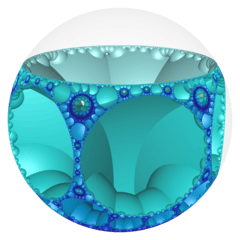 Poincaré disk model |
 Ideal surface |
Order-7-3 apeirogonal honeycomb
| Order-7-3 apeirogonal honeycomb | |
|---|---|
| Type | Regular honeycomb |
| Schläfli symbol | {∞,7,3} |
| Coxeter diagram | |
| Cells | {∞,7}  |
| Faces | Apeirogon {∞} |
| Vertex figure | {7,3} |
| Dual | {3,7,∞} |
| Coxeter group | [∞,7,3] |
| Properties | Regular |
In the geometry of hyperbolic 3-space, the order-7-3 apeirogonal honeycomb (or ∞,7,3 honeycomb) a regular space-filling tessellation (or honeycomb). Each infinite cell consists of an order-7 apeirogonal tiling whose vertices lie on a 2-hypercycle, each of which has a limiting circle on the ideal sphere.
The Schläfli symbol of the apeirogonal tiling honeycomb is {∞,7,3}, with three order-7 apeirogonal tilings meeting at each edge. The vertex figure of this honeycomb is a heptagonal tiling, {7,3}.
The "ideal surface" projection below is a plane-at-infinity, in the Poincaré half-space model of H3. It shows an Apollonian gasket pattern of circles inside a largest circle.
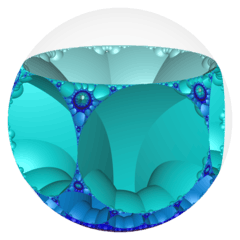 Poincaré disk model |
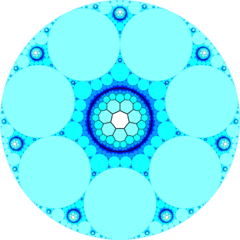 Ideal surface |
Order-7-4 square honeycomb
| Order-7-4 square honeycomb | |
|---|---|
| Type | Regular honeycomb |
| Schläfli symbol | {4,7,4} |
| Coxeter diagrams | |
| Cells | {4,7}  |
| Faces | {4} |
| Edge figure | {4} |
| Vertex figure | {7,4} |
| Dual | self-dual |
| Coxeter group | [4,7,4] |
| Properties | Regular |
In the geometry of hyperbolic 3-space, the order-7-4 square honeycomb (or 4,7,4 honeycomb) a regular space-filling tessellation (or honeycomb) with Schläfli symbol {4,7,4}.
All vertices are ultra-ideal (existing beyond the ideal boundary) with four order-5 square tilings existing around each edge and with an order-4 heptagonal tiling vertex figure.
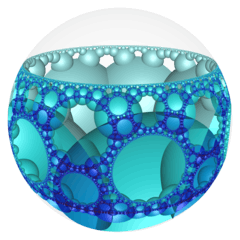 Poincaré disk model |
 Ideal surface |
Order-7-5 pentagonal honeycomb
| Order-7-5 pentagonal honeycomb | |
|---|---|
| Type | Regular honeycomb |
| Schläfli symbol | {5,7,5} |
| Coxeter diagrams | |
| Cells | {5,7}  |
| Faces | {5} |
| Edge figure | {5} |
| Vertex figure | {7,5} |
| Dual | self-dual |
| Coxeter group | [5,7,5] |
| Properties | Regular |
In the geometry of hyperbolic 3-space, the order-7-5 pentagonal honeycomb (or 5,7,5 honeycomb) a regular space-filling tessellation (or honeycomb) with Schläfli symbol {5,7,5}.
All vertices are ultra-ideal (existing beyond the ideal boundary) with five order-7 pentagonal tilings existing around each edge and with an order-5 heptagonal tiling vertex figure.
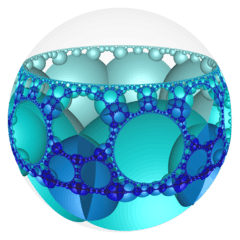 Poincaré disk model |
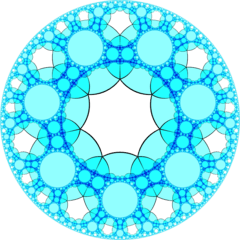 Ideal surface |
Order-7-6 hexagonal honeycomb
| Order-7-6 hexagonal honeycomb | |
|---|---|
| Type | Regular honeycomb |
| Schläfli symbols | {6,7,6} {6,(7,3,7)} |
| Coxeter diagrams | |
| Cells | {6,7}  |
| Faces | {6} |
| Edge figure | {6} |
| Vertex figure | {7,6} {(5,3,5)} |
| Dual | self-dual |
| Coxeter group | [6,7,6] [6,((7,3,7))] |
| Properties | Regular |
In the geometry of hyperbolic 3-space, the order-7-6 hexagonal honeycomb (or 6,7,6 honeycomb) is a regular space-filling tessellation (or honeycomb) with Schläfli symbol {6,7,6}. It has six order-7 hexagonal tilings, {6,7}, around each edge. All vertices are ultra-ideal (existing beyond the ideal boundary) with infinitely many hexagonal tilings existing around each vertex in an order-6 heptagonal tiling vertex arrangement.
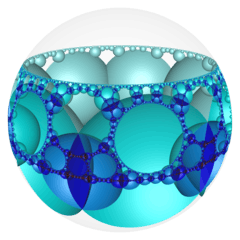 Poincaré disk model |
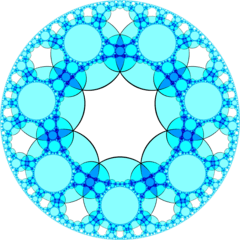 Ideal surface |
It has a second construction as a uniform honeycomb, Schläfli symbol {6,(7,3,7)}, Coxeter diagram, ![]()
![]()
![]()
![]()
![]()
Order-7-infinite apeirogonal honeycomb
| Order-7-infinite apeirogonal honeycomb | |
|---|---|
| Type | Regular honeycomb |
| Schläfli symbols | {∞,7,∞} {∞,(7,∞,7)} |
| Coxeter diagrams | |
| Cells | {∞,7}  |
| Faces | {∞} |
| Edge figure | {∞} |
| Vertex figure | |
| Dual | self-dual |
| Coxeter group | [∞,7,∞] [∞,((7,∞,7))] |
| Properties | Regular |
In the geometry of hyperbolic 3-space, the order-7-infinite apeirogonal honeycomb (or ∞,7,∞ honeycomb) is a regular space-filling tessellation (or honeycomb) with Schläfli symbol {∞,7,∞}. It has infinitely many order-7 apeirogonal tiling {∞,7} around each edge. All vertices are ultra-ideal (existing beyond the ideal boundary) with infinitely many order-7 apeirogonal tilings existing around each vertex in an infinite-order heptagonal tiling vertex figure.
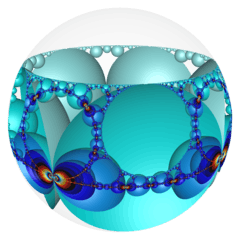 Poincaré disk model |
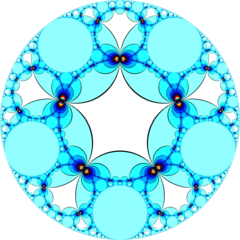 Ideal surface |
It has a second construction as a uniform honeycomb, Schläfli symbol {∞,(7,∞,7)}, Coxeter diagram, ![]()
![]()
![]()
![]()
![]()
![]()
See also
- Convex uniform honeycombs in hyperbolic space
- List of regular polytopes
References
- Hyperbolic Catacombs Roice Nelson and Henry Segerman, 2014
- Coxeter, Regular Polytopes, 3rd. ed., Dover Publications, 1973. ISBN 0-486-61480-8. (Tables I and II: Regular polytopes and honeycombs, pp. 294–296)
- The Beauty of Geometry: Twelve Essays (1999), Dover Publications, LCCN 99-35678, ISBN 0-486-40919-8 (Chapter 10, Regular Honeycombs in Hyperbolic Space) Table III
- Jeffrey R. Weeks The Shape of Space, 2nd edition ISBN 0-8247-0709-5 (Chapters 16–17: Geometries on Three-manifolds I,II)
- George Maxwell, Sphere Packings and Hyperbolic Reflection Groups, JOURNAL OF ALGEBRA 79,78-97 (1982)
- Hao Chen, Jean-Philippe Labbé, Lorentzian Coxeter groups and Boyd-Maxwell ball packings, (2013)
- Visualizing Hyperbolic Honeycombs arXiv:1511.02851 Roice Nelson, Henry Segerman (2015)
External links
- Hyperbolic Catacombs Carousel: {3,7,3} honeycomb YouTube, Roice Nelson
- John Baez, Visual insights: {7,3,3} Honeycomb (2014/08/01) {7,3,3} Honeycomb Meets Plane at Infinity (2014/08/14)
- Danny Calegari, Kleinian, a tool for visualizing Kleinian groups, Geometry and the Imagination 4 March 2014.